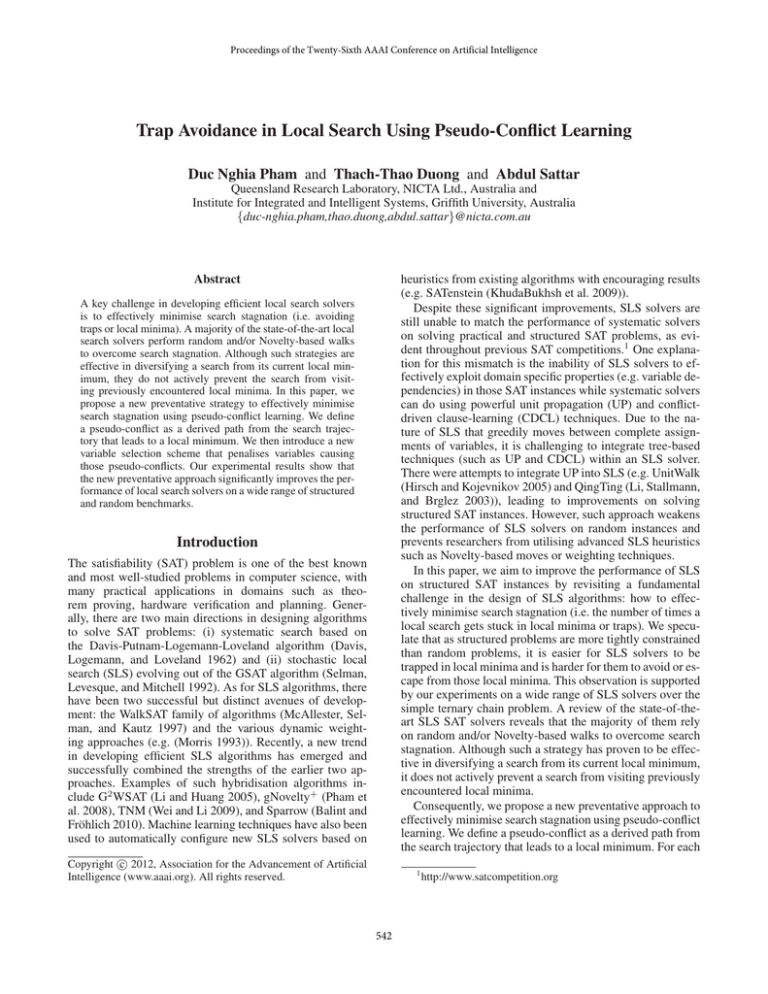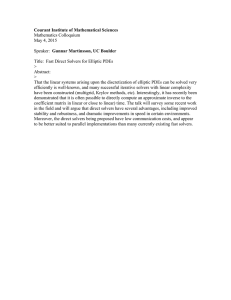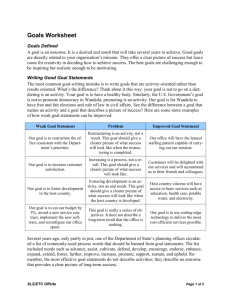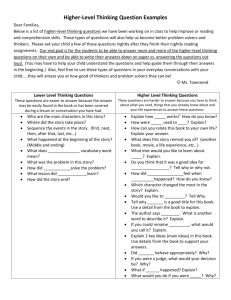
Proceedings of the Twenty-Sixth AAAI Conference on Artificial Intelligence
Trap Avoidance in Local Search Using Pseudo-Conflict Learning
Duc Nghia Pham and Thach-Thao Duong and Abdul Sattar
Queensland Research Laboratory, NICTA Ltd., Australia and
Institute for Integrated and Intelligent Systems, Griffith University, Australia
{duc-nghia.pham,thao.duong,abdul.sattar}@nicta.com.au
Abstract
heuristics from existing algorithms with encouraging results
(e.g. SATenstein (KhudaBukhsh et al. 2009)).
Despite these significant improvements, SLS solvers are
still unable to match the performance of systematic solvers
on solving practical and structured SAT problems, as evident throughout previous SAT competitions.1 One explanation for this mismatch is the inability of SLS solvers to effectively exploit domain specific properties (e.g. variable dependencies) in those SAT instances while systematic solvers
can do using powerful unit propagation (UP) and conflictdriven clause-learning (CDCL) techniques. Due to the nature of SLS that greedily moves between complete assignments of variables, it is challenging to integrate tree-based
techniques (such as UP and CDCL) within an SLS solver.
There were attempts to integrate UP into SLS (e.g. UnitWalk
(Hirsch and Kojevnikov 2005) and QingTing (Li, Stallmann,
and Brglez 2003)), leading to improvements on solving
structured SAT instances. However, such approach weakens
the performance of SLS solvers on random instances and
prevents researchers from utilising advanced SLS heuristics
such as Novelty-based moves or weighting techniques.
In this paper, we aim to improve the performance of SLS
on structured SAT instances by revisiting a fundamental
challenge in the design of SLS algorithms: how to effectively minimise search stagnation (i.e. the number of times a
local search gets stuck in local minima or traps). We speculate that as structured problems are more tightly constrained
than random problems, it is easier for SLS solvers to be
trapped in local minima and is harder for them to avoid or escape from those local minima. This observation is supported
by our experiments on a wide range of SLS solvers over the
simple ternary chain problem. A review of the state-of-theart SLS SAT solvers reveals that the majority of them rely
on random and/or Novelty-based walks to overcome search
stagnation. Although such a strategy has proven to be effective in diversifying a search from its current local minimum,
it does not actively prevent a search from visiting previously
encountered local minima.
Consequently, we propose a new preventative approach to
effectively minimise search stagnation using pseudo-conflict
learning. We define a pseudo-conflict as a derived path from
the search trajectory that leads to a local minimum. For each
A key challenge in developing efficient local search solvers
is to effectively minimise search stagnation (i.e. avoiding
traps or local minima). A majority of the state-of-the-art local
search solvers perform random and/or Novelty-based walks
to overcome search stagnation. Although such strategies are
effective in diversifying a search from its current local minimum, they do not actively prevent the search from visiting previously encountered local minima. In this paper, we
propose a new preventative strategy to effectively minimise
search stagnation using pseudo-conflict learning. We define
a pseudo-conflict as a derived path from the search trajectory that leads to a local minimum. We then introduce a new
variable selection scheme that penalises variables causing
those pseudo-conflicts. Our experimental results show that
the new preventative approach significantly improves the performance of local search solvers on a wide range of structured
and random benchmarks.
Introduction
The satisfiability (SAT) problem is one of the best known
and most well-studied problems in computer science, with
many practical applications in domains such as theorem proving, hardware verification and planning. Generally, there are two main directions in designing algorithms
to solve SAT problems: (i) systematic search based on
the Davis-Putnam-Logemann-Loveland algorithm (Davis,
Logemann, and Loveland 1962) and (ii) stochastic local
search (SLS) evolving out of the GSAT algorithm (Selman,
Levesque, and Mitchell 1992). As for SLS algorithms, there
have been two successful but distinct avenues of development: the WalkSAT family of algorithms (McAllester, Selman, and Kautz 1997) and the various dynamic weighting approaches (e.g. (Morris 1993)). Recently, a new trend
in developing efficient SLS algorithms has emerged and
successfully combined the strengths of the earlier two approaches. Examples of such hybridisation algorithms include G2 WSAT (Li and Huang 2005), gNovelty+ (Pham et
al. 2008), TNM (Wei and Li 2009), and Sparrow (Balint and
Fröhlich 2010). Machine learning techniques have also been
used to automatically configure new SLS solvers based on
c 2012, Association for the Advancement of Artificial
Copyright Intelligence (www.aaai.org). All rights reserved.
1
542
http://www.satcompetition.org
variable, we maintain the number of times it involved in
a pseudo-conflict. We then use those frequencies to prioritise variables for selecting the next move and hence prevent the search from revisiting those local minima. To the
best of our knowledge, this is a new approach that utilises
variable weights for learning pseudo-conflicts although variable weights have been used before. In (Prestwich 2005),
the flip time of a variable was used as its weight to prefer the search to the least recently flipped variable. TNM
(Wei and Li 2009) exploited this variable weight concept
to switch between two noise heuristics to escape from local
minima. Alternatively, BGWalkSAT (Zhang, Rangan, and
Looks 2003) calculated the frequency a literal appears in
a near (optimal) solution (i.e. local minima) during a number of short runs. These pseudo-backbone frequencies were
then used as literal weights to guide the search in the solving
phase. Mazure, Sais, and Grégoire (1998) used a slightly different version of literal weights (i.e. the frequency a literal
appears in a falsified clause) computed during an SLS phase
to boost the performance of its main systematic solver. Cha
and Iwama (1996) added resolvent clauses between pairs
of falsified clauses in a local minimum to escape from it.
This technique was later improved by (Fang and Ruml 2004;
Shen and Zhang 2005). Audemard et al. (2010) ran a CDCL
solver to assign values to all variables in a falsified clause
when its main SLS solver reached a local minimum. It then
resumed the SLS phase of which the partial assignment (provided by the CDCL solver) was fixed in order to prevent local search from revisiting that trap.
In the remainder of the paper, we firstly review existing
heuristics to avoid and/or escape from local minima. We
then provide a detailed description of our pseudo-conflict
learning heuristic followed by an experimental evaluation
on a wide range of structured and random benchmarks. Our
results show that the new learning strategy significantly improves the performance of SLS solvers (in orders of magnitude) on those benchmarks. Finally, we present our conclusions and outline some directions for future research.
A well-known strategy to escape from local minima is to
perform a random walk whenever a local minimum is encountered. It is widely used by the WalkSAT family of algorithms (McAllester, Selman, and Kautz 1997). With a walk
probability wp, WalkSAT/G and WalkSAT/B both perform a
random walk move by flipping a random variable from a random clause. In addition, WalkSAT/SKC, if possible, always
favours a freebie move over a random walk move. A freebie
move is a move that does not falsify any satisfied clauses.
Later, Hoos (2002) proved that occasionally performing random walks helps to reduce search stagnation.
With the introduction of G2 WSAT, Li and Huang (2005)
replaced random walks with Novelty walks (i.e. using the
Novelty algorithm to select a move) to effectively escape
from local minima. Novelty (McAllester, Selman, and Kautz
1997), one of the most competitive WalkSAT variants,
greedily selects the best scoring variable v from a random
unsatisfied clause c, breaking ties by selecting the least recently flipped variable. If v is the most recently flipped variable, then the second best variable from clause c will be selected with a noise probability p. Since then, many state-ofthe-art SLS solvers (such as gNovelty+ (Pham et al. 2008)
and TNM (Wei and Li 2009)) have employed this strategy
but opted to use AdaptNovelty (Hoos 2002), an adaptive version of Novelty.
Although these strategies are effective in diversifying the
search from its traps, they do not actively prevent the search
from visiting previous traps. A simple strategy to avoid previous local minima is the Tabu heuristic (Taillard 1991). It
keeps a list of k most recently flipped variables. By forbidding the search from selecting variables in this tabu list, it
exhausts all the neighbour assignments and consequently escapes from the local minimum. Arguably, if the tabu tenure
(i.e. the length of this tabu list) is long enough, tabu heuristic can also help the search avoid previous traps. However,
the performance of a tabu-based algorithm significantly depends on setting the right tabu tenure, which varies vastly
for different instances (even from the same problem).
A more effective approach to deal with local minima is
to use weighting strategy. Clause weighting techniques (as
used in SAPS (Hutter, Tompkins, and Hoos 2002), PAWS
(Thornton et al. 2004) and gNovelty+ (Pham et al. 2008))
associate a weight to each CNF clause. They then use a
weighted scoring function (e.g. the sum of weights of all
unsatisfied clauses) to guide the search. Whenever a local
minimum is encountered, the weights of all currently unsatisfied clauses are increased. This alters the search landscape
by gradually filling the gap and hence escape from that local minimum. As those new clause weights are also used
to select subsequent moves, it prevents the search from getting stuck in previous known traps. In addition, it is widely
believed and has been empirically shown that periodically
reducing clause weights dramatically improves the performance of clause weighting algorithms as it forces the search
to forget long-term memory of encountered traps (Hutter,
Tompkins, and Hoos 2002; Thornton et al. 2004).
Alternatively, Prestwich (2005) used variable weights
(i.e. the number of times a variable has been flipped) to avoid
traps. His VW algorithm selects a move similarly to Walk-
Existing Heuristics for Trap Avoidance in SLS
One of the key challenges in developing SLS solvers is to
handle traps or local minima. Generally, an SLS solver starts
with a random assignment of truth values to all variables in
the given CNF formula. It then iteratively attempts to modify
the current assignment until it finds an assignment satisfying
all the CNF clauses or it is terminated. At each iteration, the
search replaces the current assignment with one of its neighbours by flipping the value of one selected variable.2 The
aim here is to greedily move to a neighbour that minimises
a predefined scoring function (e.g. the number of unsatisfied
clauses). Given its nature, an SLS solver tends to get trapped
into a local minimum where moving to any surrounding assignment cannot yield a better score than the current one. As
a result, the performance of an SLS solver heavily depends
on how effectively it can escape and avoid local minima.
2
Although there is no restriction on how many variables can be
flipped at each iteration, the majority of SLS SAT solvers elect to
flip only one variable at each iteration.
543
SAT/SKC but breaks ties by selecting one with the smallest
weight and breaks further ties randomly. The more advanced
VW2 variant also performs continuous smoothing of variable weights similarly to clause weighting algorithms.
Recently, Balint and Fröhlich (2010) introduced a new
trap escaping heuristic that combined the advantages of the
clause weighted scoring scheme and a Novelty walk. The
idea was to calculate a probability distribution of variables
from a random unsatisfied clause. Their new algorithm,
Sparrow, was based on gNovelty+ and replaced the AdaptNovelty component in gNovelty+ with the new probability distribution based variable selection mechanism. Sparrow2011 (Balint et al. 2011), the latest version of Sparrow,
won two Gold medals in the 2011 SAT competition.
Experiments on the Ternary Chain Problem
In order to evaluate the effectiveness of existing strategies
for trap avoidance, we conducted an experiment using seven
different SLS solvers on a set of ternary chain instances. Table 1 lists those solvers together with the strategies they employ to escape and/or avoid traps. It is worth mentioned that
TNM uses a variant of VW algorithm to switch between two
variants of the Novelty strategy when encountering traps.
Solvers
adaptG2 WSAT0
(Li, Wei, and Zhang 2007)
TNM
(Wei and Li 2009)
RoTS
(Taillard 1991)
PAWS
(Thornton et al. 2004)
VW2
(Prestwich 2005)
gNovelty+ (v1.2)
(Pham et al. 2008)
Sparrow2011
(Balint et al. 2011)
random
walk
Novelty
walk
X
X
X
X
(two variants)
Tabu
variable
weight
Figure 1: The performance of seven benchmarked solvers on
small ternary chain instances. Each data point (except those
in the success rate plot) is the median result over 100 runs.
and 4GB of RAM for each processor. As shown in Figure 1, adaptG2 WSAT0 and TNM (which mainly use Novelty walk strategy) are the worst performers, following by
RoTS (which uses tabu strategy). None of them could solve
instances with size greater than 50. Our experiment also
confirms what Prestwich (2005) observed in his study that
weighting techniques are more effective than other strategies in avoiding traps. Indeed, VW2 and gNovelty+ successfully solved all tested instances with 100% success rate
whilst Sparrow2011 (the worst performer among the four
weighting solvers) managed to solve instances with size up
to 75. Finally, our experiment shows that gNovelty+ is the
best performer among the seven benchmarked solvers.
clause prob.
weight dist.
X
(indirectly)
X
X
X
X
X
X
X
(weighted)
X
X
X
X
X
Pseudo-Conflict Learning
Table 1: Trap avoidance strategies used by tested solvers.
Although VW2 came second in our previous experiment, its
performance curves, especially the number of flips and the
number of local minima encountered, closely resemble those
of gNovelty+ (as shown in Figure 1). Pairwise, both algorithms perform random walks occasionally. However, VW2
implements a lighter and simpler weighting heuristic than
gNovelty+ . As previously described, VW2 always selects
the least flipped variable to diversify the search to freshly
new or poorly explored areas. In fact, Wei, Li, and Zhang
(2008) pointed out that VW algorithms are more diversified than adaptG2 WSAT (Li, Wei, and Zhang 2007), which
arguably is a non-weighted variant of gNovelty+ . This is
confirmed by the results reported in Figure 1. In addition,
our experiment also shows that VW2 performs much better
than PAWS, which is arguably a variant of gNovelty+ without Tabu (with the tenure = 1) and weighted Novelty walks.
Therefore, it raises the question of whether we can combine
the advantages of clause and variable weighting strategies to
further minimise search stagnation.
The probability distribution based heuristic in Sparrow
(Balint and Fröhlich 2010) can be viewed as a form of combining clause weighting and variable weighting to escape
Prestwich (2002) defined the ternary chain problem as:
(v1 ) ∧ (v2 ) ∧ (v1 ∧v2 → v3 ) ∧ . . . ∧ (vn−2 ∧vn−1 → vn )
We selected this problem as it closely simulates the
chains of variable dependencies, regularly found in highlystructured problems from real-world domains such as hardware/software verification and planning. The problem contains only a single solution (where all variables are true) and
can be easily solved using UP. However, it poses many traps
for SLS solvers and remains a challenge for them to solve.
In fact, it was proved to be exponentially hard for random
walk algorithms (Wei and Selman 2002) and is highly recommended for evaluating the performance of SLS solvers
(Prestwich 2002; Wei and Selman 2002; Prestwich 2005).
Figure 1 plots the performance of tested solvers on small
instances with size ranging from 10 to 100 in steps of
5. Each solver was run 100 times on each instance and
each run was limited to 20 seconds. Default settings were
used for all solvers. The experiment was conducted on a
SunFire v20z cluster, which runs Fedora Core OS and is
equipped with dual-core 2.6GHz AMD Opteron processors
544
from local minima. Its probability distribution function
Algorithm 1: Pseudo-conflict learning
Input: the current iteration it, the pseudo-conflict tenure k, a time window T
ps (vi ) ∗ pa (vi )
p(vi ) = P
vi ps (vi ) ∗ pa (vi )
1 for i = 0; i < k; i++ do frequency(search history[it-i].variable)++;
2 if a time window T has elapsed then
3
gives priority to variables vi with higher clause weighted
score wscore(vi ) (as in ps (vi ) = c1 wscore(vi ) ). It also uses
age(vi ), the last iteration that vi was flipped, to assist the
variable selection. If vi was recently flipped, its probability
i ) c2
will be discounted by pa (vi ) = ( age(v
) +1. However, the
c3
probability of vi being selected will be greatly enhanced if it
was flipped long ago (i.e. its age ≥ c3 ). Note that c1 , c2 , and
c3 are parameters. Unfortunately, Sparrow2011 is the worst
performer among the four benchmarked weighting solvers.
In this work, we want to capture the cause of a conflict
in the current local minimum and then use it to prevent the
local search from revisiting that trap. Currently, systematic
solvers that use the CDCL mechanism are very effective
in avoiding previous traps. This CDCL mechanism actively
monitors the current assignment for conflicts. Whenever a
conflict is detected, it will perform resolution to find the
cause of that conflict. Such a cause is recorded and then used
to prevent the search from falling into that trap again. Unfortunately, we cannot directly implement a CDCL scheme
within an SLS solver due to its nature of operation.
Therefore in order to approximately record the cause of
a local minimum, we introduce the pseudo-conflict concept.
Whenever a local search hits a local minimum, we hypothesise that the assignment of the k most recently flipped variables is actually the cause of this conflict. Obviously, there
is no trivial method to work out the exact value of k rather
than guessing. Hence, we call such segment of the search
trajectory that contains the last k flipped variables a pseudoconflict. In our implementation, we opted to set a small value
for k as we observed that small pseudo-conflicts were practically the best approximation of conflict causes.
Ideally, one would record all derived pseudo-conflicts to
prevent the search from visiting a previously encountered
trap. However, this may require a lot of memory to store
them. In addition, the overhead of ensuring that a potential candidate variable, if flipped, will not lead to a known
trap can make a significant negative impact on the solver’s
performance. Thus, we decided to adopt the variable weight
concept to record pseudo-conflicts and guide the search.
Algorithm 1 outlines our pseudo-conflict learning (PCL)
mechanism. We associate with each variable vi a frequency
weight to record the number of times that vi is involved in a
pseudo-conflict. Whenever a local minimum is encountered,
the weights of the k most recently flipped variables are increased by 1 (line 1). In a subsequent variable selection, they
are used to break ties, preferring the variable with the lowest weight. Like other weighting techniques, we also reduce
those weights periodically to counter the long-term memory
effect. Every time a time window T elapses, we reduce the
weights of all weighted variables by half (lines 2-5).
Note that our PCL mechanism is significantly different to
the Tabu heuristic. A Tabu solver memorises only the most
recent pseudo-conflict (its size is equal to the Tabu tenure).
Hence, if one sets the Tabu tenure large enough to cover
4
5
foreach variable vi do
if frequency(vi ) > 1 then reduce frequency(vi ) by half;
else frequency(vi ) ← 0;
a reasonable number of known traps, it is more likely that
many good moves are also tabooed. It is also bad if the
tenure is too small as the search only has a short-term memory of one or two most recent traps. In contrast, our PCL
mechanism can memorise a reasonable amount of known
traps without severely ruling out good candidate variables.
Integrating PCL within SLS Solvers
Here, we describe how our PCL mechanism is integrated
into gNovelty+ and Sparrow2011. The two new algorithms,
gNovelty+ PCL and Sparrow2011-PCL, are outlined in Algorithms 2 and 3 respectively. The differences between PCL
solvers and their original ones are also highlighted.
Algorithm 2: gNovelty+ PCL(Θ)
Input: A CNF formula Θ
Output: A solution α (if found) or TIMEOUT
1 randomly generate an assignment α;
2 while not timeout do
3
4
5
6
7
8
9
10
11
12
13
14
if α satisfies Θ then return α as the solution;
if within a walking probability wp then
randomly select a variable v that appears in an unsatisfied clause;
else
if there exist promising variables then
select the most promising variable v, breaking ties by selecting
the least pseudo-conflicted variable;
else
perform pseudo-conflict learning;
update (and smooth within a probability sp) clause weights;
select the most improving variable v from a random unsatisfied
clause, breaking ties by selecting the least pseudo-conflicted
variable;
update α with the flipped value of v;
update the search trajectory;
15 return TIMEOUT;
gNovelty+ PCL We firstly removed the Tabu heuristic out
of gNovelty+ PCL as its benefit is now cover by our PCL
mechanism. We then modified its gradient-based variable
selection. When there are two or more promising variables
with the same highest score, we will select the least pseudoconflicted one (i.e. a variable with the lowest frequency
weight) instead of selecting the least recently flipped variable (as gNovelty+ does). The reason for this change is to
favour a move that less likely leads to a known trap. We will
also break ties when performing the weighted AdaptNovelty
walk by favouring the least pseudo-conflicted variable.
545
of local minima encountered, the number of CPU seconds
and the number of flips. Unfortunately, Sparrow2011-PCL
was unable to solve all small instances with 100% success
rate. However, gNovelty+ PCL clearly outperformed other
solvers on larger instances (as shown in Figure 3).
Algorithm 3: Sparrow2011-PCL(Θ)
Input: A CNF formula Θ
Output: A solution α (if found) or TIMEOUT
1 randomly generate an assignment α;
2 while not timeout do
3
4
5
6
7
8
9
10
11
if α satisfies Θ then return α as the solution;
if there exist promising variables then
select the most promising variable v, breaking ties by selecting the
least pseudo-conflicted variable;
else
perform pseudo-conflict learning;
update (and smooth within a probability sp) clause weights;
select the highest probability variable v from a random unsatisfied
clause using the new probability distribution;
update α with the flipped value of v;
update the search trajectory;
Figure 3: Large ternary chains: no omitted solver could solve
any instance.
12 return TIMEOUT;
We then ran a new experiment on three real-world verification problem suites: (i) 100 sss-sat-1.0 superscalar microprocessors verification instances,3 (ii) 39 cbmc bounded
model checking instances, and (iii) 75 swv software verification instances generated by the C ALYSTO checker.4
The experimental results are summarised in Table 2 and
depicted in Figure 4. The parameter settings for PCL solvers
are reported in Table 4. All solvers were run 50 times for
each instance and each run was timed out after 600 seconds.
The experiment was conducted on a cluster equipped with
hexa-core CPUs (Intel Xeon X5650 @2.67GHz, 12MB L2
Cache) and 2GB RAM per core, running Red Hat Santiago
OS. For each benchmark set in Table 2, we report (i) the
percentage success rate; and (ii) the mean-of-minimum, the
mean-of-mean and the mean-of-maximum solution-times in
seconds. The percentage success rate of a benchmark is calculated as the percentage of solved instances in that benchmark set. An instance is considered solved if its success rate
Sparrow2011-PCL We removed the Tabu heuristic from
Sparrow2011-PCL and modified its gradient-based variable
selection to favour the least pseudo-conflicted variable when
there is a tie. We also replaced the pa (vi ) component in the
probability function p(vi ) with the new component pf (vi ) =
c5
)c4 + 1. This favours variables involved in
( f requency(v
i )+1
a small number of pseudo-conflicts (≤ c5 ) and heavily penalises those highly leading to traps.
Experimental Results and Analysis
We firstly compared the performance of gNovelty+ PCL and
Sparrow2011-PCL against other solvers on ternary chain instances. We further included large instances with size ranging from 100 to 1000 in steps of 50. All settings are kept
the same as in our previous experiment. The new results
are summarised in Figures 2 and 3. Each data point (except
those in the success rate plots) is the median result over 100
runs. As shown in Figure 2, our PCL mechanism greatly
enhances the performance of gNovelty+ and Sparrow2011
up to an order of magnitude on three measures: the number
3
http://www.miroslav-velev.com/sat benchmarks.html
The cbmc and swv instances are test instances from
http://people.cs.ubc.ca/∼davet/papers/sat10-dave-instances.zip
4
Figure 4: gNovelty+ PCL vs. others: CPU time performance
Figure 2: Small ternary chains.
546
TNM
Instances
%sr
cbmc (39)
92%
swv (75)
23%
sss-sat-1.0 (100)
18%
VW2
#secs
13.399
76.599
164.602
464.005
464.013
464.037
350.904
517.709
546.742
%sr
31%
23%
24%
#secs
362.911
439.128
498.058
464.133
466.002
474.762
318.728
481.357
523.310
Sparrow2011
%sr
#secs
119.692
51% 384.359
499.474
413.379
21% 486.949
519.651
484.792
7% 572.993
588.703
Sparrow2011-PCL
%sr
#secs
158.482
59% 311.671
461.666
461.103
23% 465.217
472.802
324.935
22% 498.615
531.340
gNovelty+
%sr
#secs
54.573
85% 247.997
382.512
409.451
25% 459.097
464.131
162.757
50% 348.512
427.622
gNovelty+ PCL
%sr
#secs
0.044
100%
2.378
28.643
304.774
48% 326.605
357.854
0.154
100%
2.370
16.667
minisat2.2
%sr
#secs
glucose2
%sr
#secs
100%
0.009
100%
0.011
100%
0.138
100%
0.143
100%
0.211
100%
0.216
Table 2: The performance of difference solvers on verification instances.
Instances
application
(8)
crafted
(82)
large
random
(64)
medium
random
(201)
Sparrow2011
%sr
#secs
461.824
25%
515.799
543.695
237.720
56%
285.159
338.434
437.202
20% 509.487
555.076
5.049
100%
40.671
99.540
Sparrow2001-PCL
%sr
#secs
461.207
25% 477.668
542.149
217.799
59% 270.204
307.305
443.579
19% 524.496
568.140
3.161
99%
31.429
87.231
gNovelty+
%sr
#secs
464.149
12% 527.431
527.503
202.872
62% 251.332
285.784
576.600
0%
n/a
600.000
130.371
75% 184.698
241.121
gNovelty+ PCL
%sr
#secs
229.016
50% 373.847
479.386
67.631
84% 114.586
156.552
313.537
25%
515.067
581.770
3.851
100%
13.487
46.103
minisat2.2
%sr
#secs
glucose2
%sr
#secs
100%
14.560
100%
4.055
51.21%
336.279
43.90%
362.970
0%
n/a
0%
n/a
13.15%
512.980
17.46%
541.407
Table 3: The performance of difference solvers on SAT-2011 benchmark instances.
is at least 50%. The overall means are taken over the minimums, means and maximums time to solve each instance.
Again, statistics on solution-time are only on successful runs
and when success rate is at least 50%. Furthermore, we also
included in Table 2 the results of two CDCL solvers: minisat2.2 and glucose2.
gNovelty+ PCL
k
T
sp
k
cbmc
25
100
35
25
300
1
16.0
smv
10
300
5
25
250
12
16.5
sss-sat-1.0
20
100
5
25
300
3
8.0
sat-2011
15
250
0
30
300
1
1.5
Problems
rameter settings for PCL solvers on SAT 2011 benchmarks
are reported in Table 4. The new results are summarised in
Table 3. Here we only report results on instances that can be
solved by at least one SLS solver. Note that all statistics in
Table 3 are computed in the similar manner to those in Table
2. Once again, our new results, as shown in Table 3, demonstrate the significant benefits of integrating PCL mechanism
with gNovelty+ on both random and structured instances.
Finally, it is worthy to note that constraint propagation
has been successfully used in structure-based SLS solvers
(Pham, Thornton, and Sattar 2007; Belov, Järvisalo, and
Stachniak 2011). However, there is little report on how they
perform on non-structured (especially random) instances.
The structure-based solver in (Pham, Thornton, and Sattar 2007) performed significantly worse on bart instances
from which it could not derive any structure information
(see Table 3 in (Pham, Thornton, and Sattar 2007)). Based
on the results reported in (Belov, Järvisalo, and Stachniak
2011), we found an interesting comparison: gNovelty+ PCL
solved all of the 100 sss-sat-1 .0 instances (with a maximum CPU time per run is 16.667s) whilst d-crsat (the best
in its structured-based SLS class) solved only 79 of these instances (with a 300s time limit per run). However, we do not
suggest that gNovelty+ PCL will perform better than d-crsat
on other structured problems. Of course, d-crsat will solve
the ternary chain instances with ease.
Sparrow2011-PCL
T
c4
c5
Table 4: Parameter settings for PCL solvers. The values were
tuned mainly based on the impact on the average flips and
not because of the overhead caused by Algorithm 1.
These results re-confirmed the benefits of our PCL mechanism on gNovelty+ and Sparrow2011. gNovelty+ PCL
solved the cbmc and sss-sat problems with 100% success.
That is 100% improvement on sss-sat-1.0 as gNovelty+
solved only 50% of this set. In addition, the CPU time performance of gNovelty+ PCL is up to many orders of magnitude better than its original. Although the improvement
for Sparrow2011-PCL is not that great, it managed to solve
22% of sss-sat instances while its counterpart Sparrow2011
achieved only 7%. Overall, gNovelty+ PCL is the best performer and significantly outperformed other benchmarked
solvers on structured verification problems (as shown in Table 2 and Figure 4).
Motivated by these results on verification problems, we
conducted another experiment on all the benchmark instances used in the 2011 SAT competition to further evaluate the performance of PCL solvers against their original solvers on the traditional benchmark problems for SLS
solvers. Each solver was run 10 times on each instance with
a 600s limit per run. The experiment was conducted on the
same hardware used in the previous verification test. The pa-
Conclusion and Future Work
In conclusion, we experimentally showed that weighting
strategies are much better than non-weighting techniques in
minimising search stagnation. We also found that the simpler and lighter variable weighting scheme used in VW2
is not that worse in comparison with the more complicated
weighting strategy employed in gNovelty+ . Based on this
observation and further analysis, we introduced a new PCL
mechanism to approximately learn the causes of conflicts for
local search solvers. This idea was inspired by the CDCL
547
Mazure, B.; Sais, L.; and Grégoire, É. 1998. Boosting complete techniques thanks to local search methods. Annals of
Mathematics and Artificial Intelligence 22(3-4):319–331.
McAllester, D. A.; Selman, B.; and Kautz, H. A. 1997. Evidence for invariants in local search. In Proceedings of AAAI97, 321–326.
Morris, P. 1993. The Breakout method for escaping from
local minima. In Proceedings of AAAI-93, 40–45.
Pham, D. N.; Thornton, J.; Gretton, C.; and Sattar, A. 2008.
Combining adaptive and dynamic local search for satisfiability. JSAT 4(2-4):149–172.
Pham, D. N.; Thornton, J.; and Sattar, A. 2007. Building
structure into local search for SAT. In Proceedings of IJCAI07, 2359–2364.
Prestwich, S. 2002. SAT problems with chains of dependent
variables. Discrete Applied Mathematics 3037:1–22.
Prestwich, S. 2005. Random walk continuously smoothed
variable weights. In Proceedings of SAT-05, 203–215.
Selman, B.; Levesque, H.; and Mitchell, D. 1992. A new
method for solving hard satisfiability problems. In Proceedings of AAAI-92, 440–446.
Shen, H., and Zhang, H. 2005. Another complete local
search method for SAT. In Proceedings of LPAR-05, 595–
605.
Taillard, E. D. 1991. Robust taboo search for the quadratic
assignment problem. Parallel Computing 17(4-5):443–455.
Thornton, J. R.; Pham, D. N.; Bain, S.; and Ferreira Jr., V.
2004. Additive versus multiplicative clause weighting for
SAT. In Proceedings of AAAI-04, 191–196.
Wei, W., and Li, C. M. 2009. Switching between two adaptive noise mechanisms in localsearch. In Booklet of SAT2009 Competition.
Wei, W., and Selman, B. 2002. Accelerating random walks.
In Proceedings of CP-02, 216–232.
Wei, W.; Li, C. M.; and Zhang, H. 2008. A switching criterion for intensification and diversification in local search for
SAT. JSAT 4(2-4):219–237.
Zhang, W.; Rangan, A.; and Looks, M. 2003. Backbone
guided local search for maximum satisfiability. In Proceedings of IJCAI-93, 1179–1186.
scheme as well as the Tabu and variable weighting heuristics. We then showed how to integrate this new mechanism
with gNovelty+ and Sparrow2011. Finally we experimentally showed that gNovelty+ PCL performed significantly
better than existing SLS solvers on both artificially generated and real-world benchmark instances. In future, we plan
to further fine-tune the PCL mechanism as well as make
these parameters to self-tune.
Acknowledgments
NICTA is funded by the Australian Government as represented by the Department of Broadband, Communications
and the Digital Economy and the Australian Research Council through the ICT Centre of Excellence program.
References
Audemard, G.; Lagniez, J.-M.; Mazure, B.; and Sais, L.
2010. Boosting local search thanks to CDCL. In Proceedings of LPAR-10, 474–488.
Balint, A., and Fröhlich, A. 2010. Improving stochastic
local search for SAT with a new probability distribution. In
Proceedings of SAT-10, 10–15.
Balint, A.; Fröhlich, A.; Tompkins, D. A.; and Hoos, H. H.
2011. Sparrow2011. In Booklet of SAT-2011 Competition.
Belov, A.; Järvisalo, M.; and Stachniak, Z. 2011. Depthdriven circuit-level stochastic local search for SAT. In Proceedings of IJCAI-11, 504–509.
Cha, B., and Iwama, K. 1996. Adding new clauses for faster
local search. In Proceedings of AAAI-96, 332–337.
Davis, M.; Logemann, G.; and Loveland, D. 1962. A machine program for theorem proving. Communications of the
ACM 5(7):394–397.
Fang, H., and Ruml, W. 2004. Complete local search for
propositional satisfiability. In Proceedings of AAAI-04, 161–
166.
Hirsch, E. A., and Kojevnikov, A. 2005. UnitWalk: A new
SAT solver that uses local search guided by unit clause elimination. Annals of Math. and AI 43(1):91–111.
Hoos, H. H. 2002. An adaptive noise mechanism for WalkSAT. In Proceedings of AAAI-02, 635–660.
Hutter, F.; Tompkins, D. A.; and Hoos, H. H. 2002. Scaling
and probabilistic smoothing: Efficient dynamic local search
for SAT. In Proceedings of CP-02, 233–248.
KhudaBukhsh, A. R.; Xu, L.; Hoos, H. H.; and LeytonBrown, K. 2009. SATenstein: Automatically building local search SAT solvers from components. In Proceedings of
IJCAI-93, 517–524.
Li, C. M., and Huang, W. Q. 2005. Diversification and
determinism in local search for satisfiability. In Proceedings
of SAT-05, 158–172.
Li, X. Y.; Stallmann, M. F. M.; and Brglez, F. 2003. QingTing: A fast SAT solver using local search and efficient unit
propagation. In Proceedings of SAT-03, 452–467.
Li, C. M.; Wei, W.; and Zhang, H. 2007. Combining adaptive noise and look-ahead in local search for SAT. In Proceedings of SAT-07, 121–133.
548






